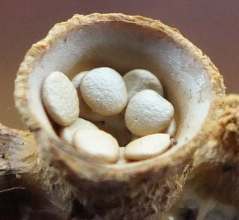 The 'Birds Nest' fungi are mushrooms that look like small nests containing tiny eggs. These harmless fungi tend to grow in large clusters, so it is common to see ten to a hundred of these 'nests' at once. The 'eggs' contain millions of fungal spores that will disperse by splashing about when it rains, and grow into a new fungi. Birds nest fungi, like all decomposers, obtain nutrients by breaking down organic matter, mostly vegitative. Although they look quite different than others, they are related to the common fungi that we find in supermarkets, including button mushrooms, shitake mushrooms, and oyster mushrooms. They all belong to the same order, called Agaricales.   
Birds nest fungi have an extremely wide distribution, and are found on all continents except Antarctica. There are about 60 species. In all cases, the hollow fruiting body that resembles a nest contains 'eggs' called peridioles. The peridioles carry the spores which will disperse at maturity.  Let's look at the Common Birds Nest fungus. This fungus has the scientific name Crucibulum leave. Clinging to twigs and branches, each Common birds nest fungus looks like a clutch of 5 to 8 white eggs in a nest that's just 4–10 mm across.
Let's look at the Common Birds Nest fungus. This fungus has the scientific name Crucibulum leave. Clinging to twigs and branches, each Common birds nest fungus looks like a clutch of 5 to 8 white eggs in a nest that's just 4–10 mm across. Raindrops will fling spore sacks (periodoles), each 1.5 mm in diameter, into the air, which will each wrap a short cord around any twig it connects with, and wait for the right conditions to release its spores. |